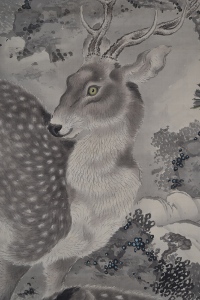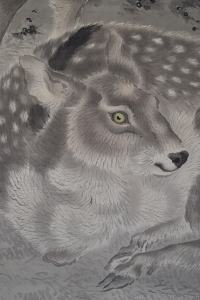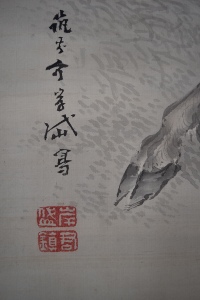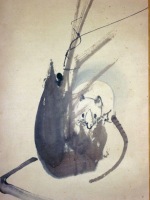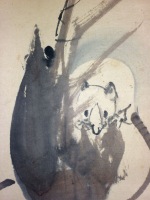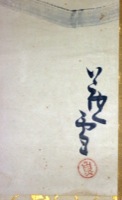Tsukioka YOSHITOSHI (1839-1892)
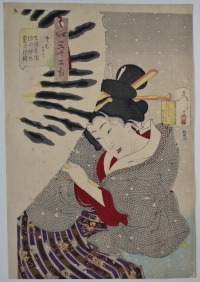
Click here to view image full size.
Samu-so: Tempo nenkan Fukagawa Nakamachi geisha fuzoku, “Looking Frozen: The Appearance of a Fukagawa Nakamachi Geisha in the Tempo Era [1830-1844].” Shows a beauty caught in a snowstorm, her umbrella laden with snow from a set Thirty-two Aspects of Women published by Tsunashima Kamekichi, 1888. The set depicts women of different backgrounds and occupations from the Kansei era through to the Meiji era with punning allusions to their situation or mood.
Very fine impression of the true first edition. Fine colour and condition. Signed Yoshitoshi ga.
Status: Available
Kitagawa UTAMARO (1753-1806)
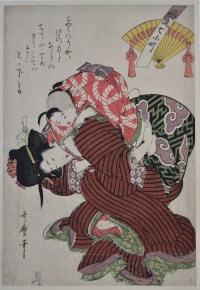
Click here to view image full size.
A beauty with a child on her back. Amagoi Komachi from a set Furyu nana Komachi, “Fashionable Seven Komachi.” Events from the life of Ono no Komachi, one of the six best waka poets of the Heian period. Published by Iseya Soemon, c. 1805.
Very good impression. Fine colour. Slight trimming, otherwise very good condition. Signed Utamaro hitsu.
Status: Available
Utagawa YOSHITSURU (Fl. c. 1840-50)
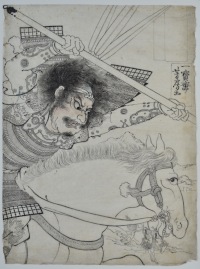
Click here to view image full size.
A fine original drawing by Yoshitsuru who was a pupil of Kuniyoshi. Sumi and slight colour on thin paper lightly adhered to a card, 13.25 x 10 in; 33.5 x 25.5 cms. The head drawn in great detail. Probably for an unpublished set of warrior prints. Shows a bajutsu samurai attacking an enemy on horseback.
In good condition apart from minor defects associated with a drawing’s survival. Signed Isseisai Yoshitsuru ga.
Status: Available
Kitagawa UTAMARO (1753-1806)
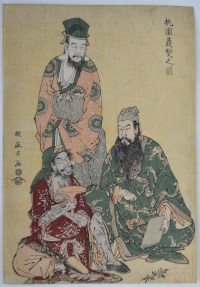
Click here to view image full size.
A scene taken from the Chinese 14th century heroic novel San guo zhi yanyi, “Romance of the Three Kingdoms” attributed to Luo Guanzhong. Shows in the centre Liu Bei (Jap. Ryubei), the founder of the Kingdom of Shu, and the two warriors, Guan Yu (Kan U) on the right and Zhang Fei (Cho Hi) on the left. The three swore pledges of brotherhood in a peach orchard. Toen gikei no zu, “Picture of the Oath in the Peach Orchard. “ Published by Tsutaya Juzaburo with early signature c 1782-3. Rare.
Fine impression. Very good colour: yellow ground. Slight crease down right edge and very small wormage near top right, otherwise very good condition. Signed Utamaro ga.
Status: Available
Tsukioka YOSHITOSHI (1839-1892)
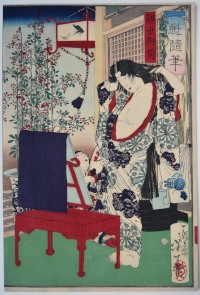
Click here to view image full size.
The great beauty Lady Kaoyo (Gozen) admires herself in a long morror. Lord Ko Moronao, the chief retainer of Shogun Ashikaga Takauji, hears of her beauty and connives to spy on her after her bath. He falls in love, but she is married to En’ya Hankan Takasada. The evil Moronao plots against En’ya although the outcome is that the family is put to death, including En’ya’s wife. The story forms the basis of the famous Chushingura tale. From the set Ikkai zuihitsu, “Essays by Yoshitoshi.” (Ikkai was an early name of Yoshitoshi’s.) A set of thirteen prints published by Masadaya Heikichi 1872/3. A fine set.
Extremely fine impression and colour from the first edition. Most designs from the set have red seals in the margin and red seals over the signature. These were removed on later editions. Trimmed on black border at left, otherwise fine condition. Signed Ikkaisai Yoshitoshi hitsu.
Status: Available
Utagawa HIROSHIGE (1797-1858)
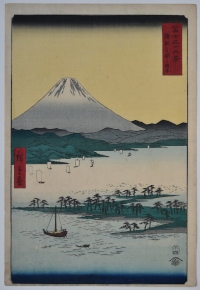
Click here to view image full size.
Suruga, Miho no Matsubara, “Pine Beach of Miho in Suruga [Province]” from Fuji sanjurokkei, “Thirty-six Views of Fuji” published by Tsutaya Kichizo, 1858. A striking design with the yellow sky and one of the best prints from the set. The Miho peninsula has a seven-kilometre seashore lined with pine trees.
Fine early impression and colour with the red signature and title labels double-printed to give a more saturated colour. Fine condition. Signed Hiroshige ga.
Status: Available
Utagawa HIROSHIGE (1797-1858)
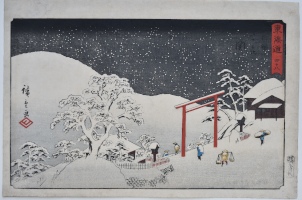
Click here to view image full size.
Seki from a Tokaido set published by Maruya Seijiro, 1850-51, hence it is often referred to as the Marusei Tokaido. Also known as the Reisho Tokaido because the title “Tokaido” is written in formal script. Below is the station number 48. Seki was located where the two highways of Tokaido and Ise-ji meet. Seki means “barrier checkpoint.” Figures pass beneath a torii gate on a snowy hillside.
Fine impression and colour. Minor edge soil, otherwise very good condition. Signed Hiroshige ga.
Status: Available
Kishi GANTAI (1782-1865)
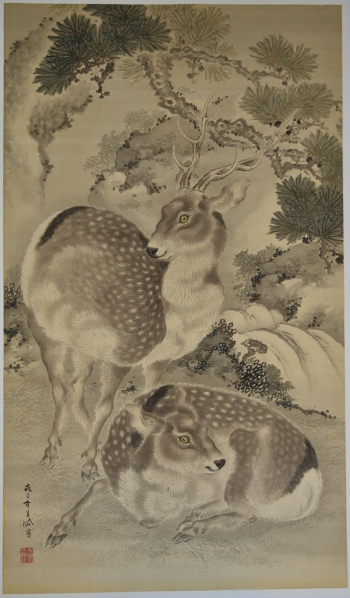
Click here to view image full size.
An extremely large painting, 55.5 x 32 in; 141 x 81.3 cms, sumi and light colour on silk. Shows a pair of Sika deer, their summer coats spotted and white. Gantai was the son and pupil of Ganku, and together with his brother, Renzan, carried on the Kishi school tradition. With his father, worked on the paintings for the new Kanazawa Castle in 1809. A highly accomplished painter, especially of kachoga. This is possibly the largest Gantai painting and it’s interesting to compare with the gajo by him also offered on this update. In very good condition. Framed and glazed. Signed Chikuzennosuke Gantai hitsu with seals Gantai and Kunchin.
Status: Available
Nagasawa ROSETSU ( 1754-1799 )

Click here to view image full size.
An original painting showing a white mouse and a spiny lobster on a tray. Rosetsu is considered one of the most important artists of the late Edo period but little is known of his short life ( he died at forty-five ) apart from the fact that he studied, and was one of the top disciples, of Maruyama Okyo. He is labelled an “eccentric” painter as he defies easy classification. His brushwork is a tour de force and he is known for his expressive depictions of animals. The Chinese-style inscription above is by Rosetsu’s friend Minagawa Kien who was a painter and scholar of Confucianism. It implies that the lobster and mouse are both signs of good fortune. Ink and light colour on paper. Image size 44.75 x 11.25 in; 113.75 x 28.5 cms.
Signed Rosetsu with seal Gyo. Painted 1790s. Inscription signed and sealed Kyosai. Slight foxing, otherwise in very good condition. One of the most copied painters. See Kono, Exhibition of Nagasawa Rosetsu, Chiba City Art Museum, 2000, pl. 42 for identical seals. Tsuji Nobu, Nagasawa Rosetsu: the Fanciful Painter, Miho Museum, 2011, pls. 19, 58-60, 67,87, 90, 91, 93 and 94.
Status: Available
Tsukioka YOSHITOSHI (1839-1892)
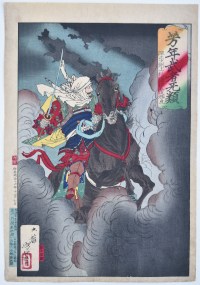
Click here to view image full size.
Uesugi Kenshin Nyudo Terutora. Shows Uesugi no Terutora (aka Kenshin) riding into battle through clouds of smoke against his long-standing adversary Takeda Shingen. From a set of 33 prints Yoshitoshi musha burui, “Yoshitoshi’s Courageous Warriors.” Published by Kobayashi Tetsujiro between 1883 and 1886, this being 1883. A fine design.
Very fine impression of the first edition. (Which should have a three-colour cartouche; two red seals and the publisher’s address in blue in the left margin.) It was reprinted by Tsunajima Kamekichi in 1886 and there are many late printings of the set. Fine colour and condition. Full size with extra paper at left. Signed Taiso Yoshitoshi ga.
Status: Available
Utagawa KUNIYOSHI (1797-1861)
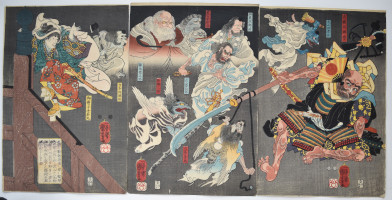
Click here to view image full size.
A triptych showing the famous battle on Gojo Bridge. The story relates how Benkei only needs one more blade to add to the 999 he has wrenched from samurai attempting to cross the bridge in order to fashion an invincible weapon. He meets Ushiwaka Maru (Minamoto no Yoshitsune’s childhood name) and challenges him to a fight on the bridge. Yoshitsune is aided by Sojobo, King of the Tengu (white-bearded in the centre) and other yamabushi tengu. Benkei loses the fight and becomes Yoshitsune’s loyal retainer. Published by Enshuya Hikobei, 1847-50. Robinson T194.
Fine impression, colour and condition. A lovely copy of this triptych. Signed Ichiyusai Kuniyoshi ga.
Status: Available
Mori SOSEN (1747-1821)
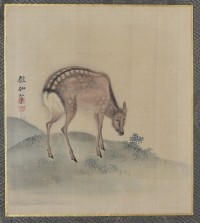
Click here to view image full size.
A fine surimono-sized painting, light colour on silk, 7.75 x 7 in; 19.5 x 17.8 cms. Shows a female sika deer. His life is not well documented but he is known to have studied under the Kano artist Yamamoto Joshunsai (?-1781) before being drawn into Maruyama Okyo’s (1735-1795) artistic circle and his style is more Shijo than anything else. His animal paintings were evidently highly valued by Okyo. He was an immediate favourite with eastern collectors because of his monkey paintings at which he excelled, although he was more versatile than literature implies and highly accomplished at painting other animals. But his images of monkeys take precedence and he is considered the pre-eminent painter, east or west, on this subject. It is alleged that he lived in the woods for three years eating fruit and nuts to study the monkeys and other animals, and is also supposed to have had a cage of monkeys at the back of his house to better observe them.
Very good condition, unmounted. Signed Sosen hitsu with seals So, Sen.
Status: Available
Tsukioka YOSHITOSHI (1839-1892)
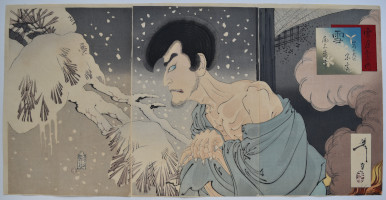
Click here to view image full size.
A triptych showing the priest Iwakura Sogen in a snowy garden. “Snow” from a set of three half-length portraits of actors with title: Setsugekka no uchi, “Snow, Moon, and Flowers.” Sogen was infatuated with the beautiful courtesan Irokotohime. He broke his vow of chastity and was expelled from his temple. Unfortunately, Irokotohime dies and Sogen is left with just his memories. There are other versions of this story and a play with the actor Onoe Baiko V. Published by Akiyama Buemon, 1890.
Fine impression of the first edition with variegated and unaltered sub-cartouche. Fine colour and condition. Signed Yoshitoshi ga.
Status: Available
Katsushika HOKUSAI (1760-1849)
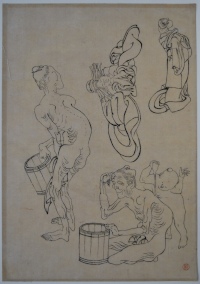
Click here to view image full size.
old lady in a bath house and two of a seated and standing beauty. (These last two studies were copied many times by Hokusai’s pupils.) Provenance: Ex Hayashi collection, seal bottom right. Good condition.
Status: Available
Attributed to Sugimura JIHEI (Active c. 1681-1703)

Click here to view image full size.
A large-size hand-coloured print showing a couple in flagrante delicto from an untitled set of twelve prints published by Hangiya Chojiro, c. 1685. (There were in fact two alternative designs added making a total of fourteen sheets.) Most reference works give this set to Moronobu. However, Timothy Clark, in the British Museum exhibition catalogue: Shunga, sex and pleasure in Japanese art, 2013, pp. 128-131 attributes the set to Jihei stating that “…this group of prints is one of the most glorious to have survived from the early period of ukiyo-e.”
Very good impression. Fine hand-colouring. Minor imperfections and signs of mounting au verso, but all compatible with the age of the print.
Status: Available
Attributed to Sugimura JIHEI (Active c. 1681-1703)

Click here to view image full size.
A large-size hand-coloured print showing a couple in flagrante delicto from an untitled set of twelve prints published by Hangiya Chojiro, c. 1685. (There were in fact two alternative designs added making a total of fourteen sheets.) Most reference works give this set to Moronobu. However, Timothy Clark, in the British Museum exhibition catalogue: Shunga, sex and pleasure in Japanese art, 2013, pp. 128-131 attributes the set to Jihei stating that “…this group of prints is one of the most glorious to have survived from the early period of ukiyo-e.”
Very good impression. Fine hand-colouring. Minor imperfections and signs of mounting au verso, but all compatible with the age of the print.
Status: Available
Hishikawa MORONOBU (?-1694)

Click here to view image full size.
A large sumizuri-e print from a shunga set of twelve published c. 1680s. In each case the couples are enclosed in a Chinese-style fan border. A couple in flagrante delicto beside a tiger and bamboo screen. Moronobu was possibly the single most influential artist and pioneered the ukiyo-e school. A painter, printmaker and illustrator.
Good impression. Minor marks, otherwise good condition.
Status: Available
Hishikawa MORONOBU (?-1694

Click here to view image full size.
A large sumizuri-e print from a shunga set of twelve published c. 1680s. In each case the couples are enclosed in a Chinese-style fan border. A couple in flagrante delicto, the women disturbed while threading a needle. Moronobu was possibly the single most influential artist and pioneered the ukiyo-e school. A painter, printmaker and illustrator.
Very good impression. Slight stains at top, otherwise very good condition.
Status: Available
Hishikawa MORONOBU (?-1694)

Click here to view image full size.
A large sumizuri-e print from a shunga set of twelve published c. 1680s. In each case the couples are enclosed in a Chinese-style fan border. A couple in flagrante delicto. Moronobu was possibly the single most influential artist and pioneered the ukiyo-e school. A painter, printmaker and illustrator.
Very good impression. A small wormhole and slight stain, otherwise very good condition.
Status: Available
Hishikawa MORONOBU (?-1694)

Click here to view image full size.
A large sumizuri-e print from a shunga set of twelve published c. 1680s. In each case the couples are enclosed in a Chinese-style fan border. A couple in flagrante delicto. Moronobu was possibly the single most influential artist and pioneered the ukiyo-e school. A painter, printmaker and illustrator.
Very good impression. A small wormhole and slight stain, otherwise very good condition.
Status: Available
Tsukioka YOSHITOSHI (1839-1892)
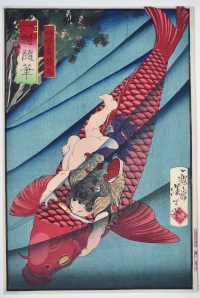
Click here to view image full size.
Shows Kintaro (aka Sakata Kaidomaru and Sakata no Kintoki) grappling with a giant carp. Kintaro, a child of herculean strength, was raised by a yama-uba on Mount Ashigara where he was befriended by the mountain animals. From the set Ikkai zuihitsu, “Essays by Yoshitoshi.” (Ikkai was an early name of Yoshitoshi’s.) A set of thirteen prints published by Masadaya Heikichi 1872/3. The masterpiece from the set and one of Yoshitoshi’s best designs. A fine set.
Extremely fine impression and colour from the first edition. Most designs from the set have red seals in the margin and red seals over the signature. These were removed on later editions. Margins trimmed a little, otherwise fine condition. Signed Ikkaisai Yoshitoshi hitsu.
Status: Available
Tsukioka YOSHITOSHI (1839-1892)
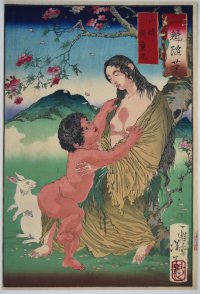
Click here to view image full size.
A fascinating print showing Kintoki (aka Kintaro and Sakata Kaidomaru) and yama-uba beneath a flowering cherry tree. Strong western elements are obvious in this design indicating a knowledge of (probably) Flemish Madonna and Child paintings or icons, Kintoki standing in for the child Jesus. Yama-uba is depicted as a bare-breasted benign mother figure, rather than the wizened witch which is how she is usually shown, having raised Kintoki on Mount Ashigara. From the set Ikkai zuihitsu, “Essays by Yoshitoshi.” (Ikkai was an early name of Yoshitoshi’s.) A set of thirteen prints published by Masadaya Heikichi 1872/3. A fine set.
Extremely fine impression and colour from the first edition with a brown Kintoki (rather than bright red) and the red seals in the margin and over signature. The white hare’s coat is blind-printed. Margins trimmed a little, otherwise fine condition. Signed Ikkaisai Yoshitoshi hitsu.
Status: Available
Toyoharu KUNICHIKA (1835-1900)
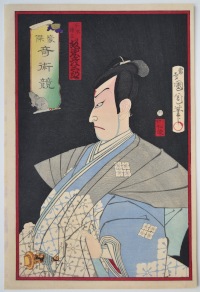
Click here to view image full size.
The actor Bando Hikosaburo V as Nikki Danjo from a set Goketsu kijutsu kurabe, “Competition of the Magicians.” Published by Matsui Eikichi, 1873/4. Hikosaburo played Nikki Danjo in the play Date zensei kuruwa kagami at the Murayama Theatre, 3/1872. The story relates how Nikki Danjo retrieves the list of conspirators against the Lord of Oshu by changing into a rat. A guard attacks the rat and strikes it on the head with an iron fan. It transmogrifies into Nikki Danjo. This sensational scene in kabuki has Nikki Danjo emerging through a trapdoor in the hanamachi in a cloud of smoke. He is usually shown with the scroll of conspirators in his mouth and a red mark on his forehead where he was hit by the fan.
Very fine impression. Fine colour and condition. Signed Oju Kunichika hitsu.
Status: Available
Utagawa HIROSHIGE (1797-1858)
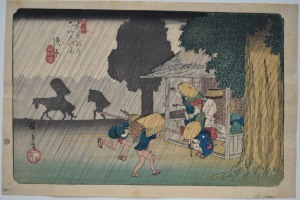
Click here to view image full size.
Station Suhara from Kisokaido rokujukyu tsugi no uchi, “Sixty-nine Stations of the Kisokaido” published by Kinjudo, 1834-1842. The road known as the Nakasendo, “central mountain route,” as opposed to the Tokaido which was the “eastern sea route” was started with Keisai Eisen and finished by Hiroshige who designed 47 prints. This is one of Hiroshige’s most famous designs. Shows travellers sheltering in a wayside shrine from heavy rain with two figures running for its shelter. In the distance, silhouetted, a figure on horseback, another following on foot. Hiroshige based his design on an illustration in Itcho gafu, “Itcho’s Picturebook” by Suzuki Rinsho, 1770. This station is famous for the number of variant states, some lighter, some darker, and variations in the gradation on the trees as the printers strove to capture this stormy scene. This is an early state.
Fine impression with crisp seals. Fine colour and condition with large margins. Signed Hiroshige ga.
Status: Available
Utagawa SADAKAGE (Fl. c. 1818-1844)
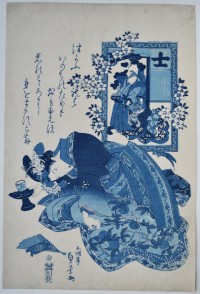
Click here to view image full size.
An aizuri-e (blue print) showing a beauty bowing obsequiously with a cup of tea. Shi, “Samurai” from a set of the Four Estates: Shi, Samurai; No, Peasant; Ko, Artisan; Sho, Merchant. Published by Kawaguchiya Chozo, c. 1830s. These blue prints using the imported bero, Berlin blue (what we called Prussian blue), became popular during the 1820s to 1840s as the cost came down.
Very good impression, colour and condition. Signed Gokotei Sadakage ga.
Status: Available
Kobayashi KIYOCHIKA (1847-1915)
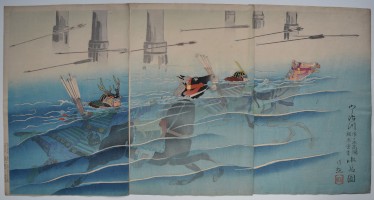
Click here to view image full size.
A triptych Ujigawa Kajiwara Kagesue, Sasaki Takatsuna, miju uma. Yoshitsune is informed that Kiso no Yoshinaka is entrenched behind the natural defence of the Uji river, then in full flood. Yoshitsune calls on Kajiwara Kagesue and Sayemon-no-jo Sasaki Shiro Takatsuna to make an attempt at fording the river. He gives them his best horses: Surusumi to Kagesue and Iketsuki to Takatsuna. They plunge into the river beside their horses with Takatsuna, dodging the hail of arrows, arriving first. One of Kiyochika’s best designs. Published 1899.
Fine impression, colour and condition. Untrimmed with margins intact. Signed Kiyochika.
Status: Available
Tsukioka YOSHITOSHI (1839-1892)
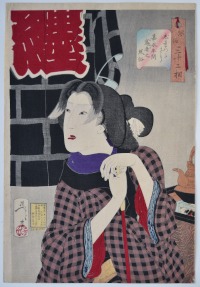
Click here to view image full size.
Jiki-tsuki-so: Kaei nenkan anego no fuzoku, “Looking as if Somebody is About to Arrive: The Appearance of a Fireman’s Wife in the Kaei Era [1848-1854].” A fireman’s wife waits for the return of the head of the household. From a set Thirty-two Aspects of Women published by Tsunashima Kamekichi, 1888. The set depicts women of different backgrounds and occupations from the Kansei era through to the Meiji era with punning allusions to their situation or mood.
Very fine impression of the true first edition. Fine colour and condition. Signed Yoshitoshi ga.
Status: Available
Katsukawa SHUN’EI (1762-1819)
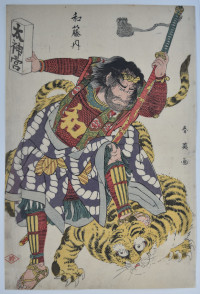
Click here to view image full size.
Shows the half-Chinese, half-Japanese hero Watonai overcomes a man-eating tiger in China by using a charm from the Ise Shrine. He holds a post with the characters reading Daijinga, “Grand Shrine” used in the inner and outer shrines at Ise. Published by Wakasaya Yoichi (Jakurindo), c 1810. Rare.
Fine impression and colour. One small backed edge wormhole, otherwise very good condition. Signed Shun’ei ga
Status: Available
Utagawa HIROSHIGE (1797-1858)
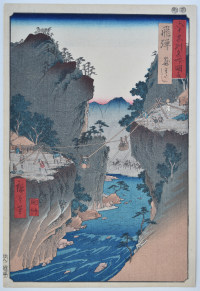
Click here to view image full size.
Hida, kago-watashi, “Basket Ropeway in Hida [Province]” from a set of 69 prints [Dai Nihon] Rokujuyoshi meisho zue, “Famous Places in the Sixty-odd Provinces [of Japan]” published by Koshihei between 1853 and 1856, this being 1853. Originating in China, Japan and northern India, travellers could cross deep ravines by suspending themselves in a harness which evolved into a basket.
Very fine impression and colour. Light album backing, otherwise fine condition. Signed Hiroshige ga.
Status: Available
TORII School (c. late 1750’s)

Click here to view image full size.
An original painting, full colour on paper with gold additions, image size 30 x 10 in; 76 x 25.5 cms. Shows a beauty holding up a puppet of the actor Bando Hikosaburo II. Painted c. late 1750s and possibly by Torii Kiyomitsu. In good condition with seal Torii.
Status: Available
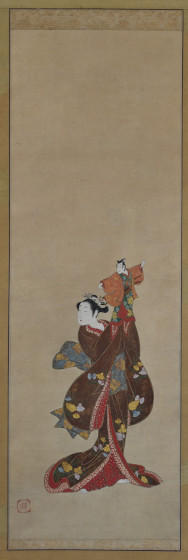
Click here to view image full size.
Utagawa KUNIYOSHI (1797-1861)
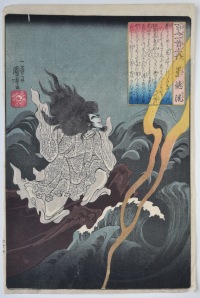
Click here to view image full size.
A poem by the celebrated poet Sutoku-in from the series Hyakunin isshu no uchi, “One Hundred Poems for One Hundred Poets” which was compiled in 1235 by Fujiwara Teiki (1162-1241). Shows the exiled Emperor Sutoku (1119-64) standing on a rocky outcrop above turbulent rapids. His wrath causes a thunderstorm with lightening. One of the very best designs from the set. Published by Ebisuya Shoshichi, Ebine, 1840-42. Only 58 of the 100 prints are known. Various translations of the poem exist, here is one:
Because the current is swift
Even though the rapids
Blocked by a boulder
Are divided, like them, in the end
We will surely meet, I know
Very fine impression. Fine colour. Very good condition. Signed Ichiyusai Kuniyoshi ga.
Status: Available
Tsukioka YOSHITOSHI (1839-1892)
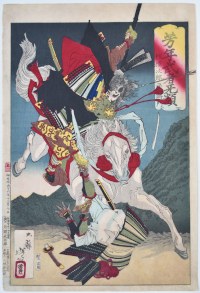
Click here to view image full size.
Shows Sagami Jiro Taira no Masakado on horseback attacking an opponent and having cut his sword in two. From a set Yoshitoshi musha burui, “Yoshitoshi’s Courageous Warriors.” Published by Kobayashi Tetsujiro, 1883.
Very fine impression: This is the first edition with three-colour cartouche and small red seals in left margin. There are late editions of this set. It was republished by Tsunajima Kamekichi in 1886. Fine colour. Slight soil bottom edge, otherwise very good condition. Signed Taiso Yoshitoshi ga.
Status: Available
Mori SOSEN (1747-1821)

Click here to view image full size.
An original painting, sumi and light colour on silk, 42.5 x 16 in; 108 x 40.5 cms. His life is not well documented but he is known to have studied under the Kano artist Yamamoto Joshunsai (?-1781) before being drawn into Maruyama Okyo’s (1735-1795) artistic circle and his style is more Shijo than anything else. His animal paintings were evidently highly valued by Okyo. He was an immediate favourite with eastern collectors because of his monkey paintings at which he excelled, although he was more versatile than literature implies and highly accomplished at painting other animals. But his images of monkeys take precedence and he is considered the pre-eminent painter, east or west, on this subject. It is alleged that he lived in the woods for three years eating fruit and nuts to study the monkeys and other animals, and is also supposed to have had a cage of monkeys at the back of his house to better observe them. This high quality painting shows two monkeys sitting on the branch of a cherry tree. Signed Sosen with two Sosen seals. In good condition.
Status: Available
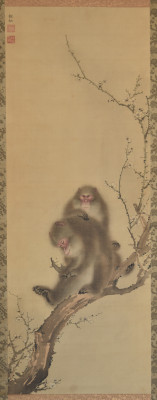
Click here to view image full size.
Ichirakutei EISUI (Active 1790-1823)
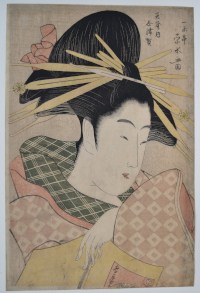
Click here to view image full size.
A fine okubi-e (“large head”) portrait of the courtesan Shizuka of the Tama-ya House. Eisui, like the other main pupils of Eishi, produced some of the finest bust-portraits in Ukiyo-e. Published by Maruya Bunemon c late 1790’s. Other impressions illustrated in Klaus J. Brandt, Hosoda Eishi, page 72, 524, no. C35, catalogued p. 231, and the Library of Congress, FP2-JPD, no. 1912. Extremely Rare.
Very good impression. Good colour. Slight soil, otherwise good condition. Full sze. Signed Ichirakutei Eisui ga.
Status: Available
Utagawa KUNIYOSHI (1797-1861)
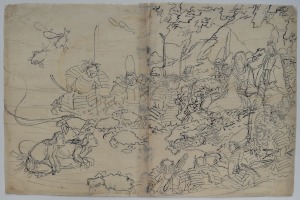
Click here to view image full size.
A fine large original drawing, sumi on thin paper, 12 x 18 in; 30.4 x 45,7 cms. Shows two awabi divers surrounded by crabs kneeling before a figure – possibly Empress Jingu – seated behind a dragon and surrounded by samurai. Provenance: Ex collection Dr. Julius Kurth (1870-1949), an eminent scholar who wrote extensively on Japanese and Chinese art.
Sold “as is” but in good condition.
Status: Available
Katsukawa SHUNSHO (1726-1793)
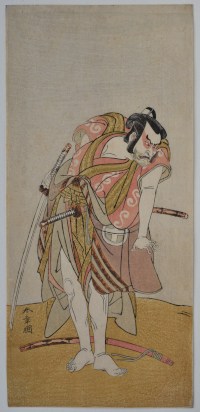
Click here to view image full size.
The actor Otani Hiroji III as a samurai, one sword drawn and facing an adversary. Shunsho was the founder of the Katsukawa school and had many pupils (including Hokusai [Shunro]). He was a prolific designer of hosoban actor prints and produced some of the finest designs in this format. Published c 1775.
Fine impression. Very good colour. Fine condition. Signed Shunsho ga.
Status: Available
Attributed to Suzuki HARUSHIGE (Shiba KOKAN 1747-1818)
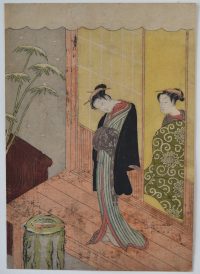
Click here to view image full size.
A winter scene with a young courtesan on an engawa gazing at an upturned ladle resting in a water basin formed from a hollow tree trunk. Behind her a young beauty peers out through the shoji. The scene calls to mind the Bell of Damnation (Muken no kane) act in the play Hiragana Seisuiki where Umegae strikes the water basin with a ladle to produce gold coins. Harushige was the ukiyo-e go of Shiba Kokan, the first artist to try copper plate engraving and who studied oil painting and etching from books he saw in Nagasaki. For a time a pupil of Harunobu whose style his prints resemble. Extremely rare: I cannot, at the moment, locate another impression. Published c early 1770s.
Fine impression. Extremely good colour, the orange pigment partly oxidised. Possibly slightly trimmed left and bottom, otherwise very good condition.
Status: Available
Torii KIYOHIRO (Active 1737-1776)
Torii KIYOHIRO
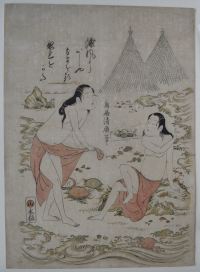
Click here to view image full size.
A large oban, 17.25 x 12.25 in; 44 x 35.2 cms, sumizuri-e with hand-applied colour. Shows two ama, abalone divers, on the seashore with nets in the background , abalone shells at their feet and an octopus in the waves below them. The poem above speaks of the salty sea breeze wafting across the shore. Published by Maruya Kuzaemon (Gyokeido) c late 1730s. Extremely rare: Another impression is in the Ritsumeikan University, https://www.dh-jac.net/db/nishikie/Z0164-003/portal/
Very good impression. Light soil, and lightly laid down. Faint fold marks, but generally good condition for its size and date. Signed Torii Kiyohiro hitsu.
Status: Available
Tsukioka YOSHITOSHI (1839-1892)
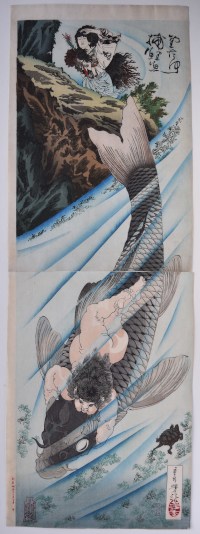
Click here to view image full size.
Kintaro rigyo o toru, “Kintaro Captures the Carp.” The “golden boy” of superhuman strength, a.k.a. Sakata no Kintoki and Kaidomaru, grapples with a giant carp which had been terrorizing the neighbourhood. There are conflicting stories about Kintaro’s origins but he is normally shown with his mother, Yama-uba, on Mount Ashigara where he developed a friendship with the mountain animals. The carp is associated with enormous strength and consequently needed great power to overcome it. From a set of fine vertical diptychs published by Matsui Eikichi, this design in 1885. It was republished by Hasegawa Tsunejiro in 1897. Arguably the best print from the set and one of Yoshitoshi’s finest designs.
Fine impression. Very good colour and condition. With full margins: This set often comes with the left margin, with the publication date, trimmed off. Signed Oju Yoshitoshi ga..
Status: Available
Tsukioka YOSHITOSHI (1839-1892)
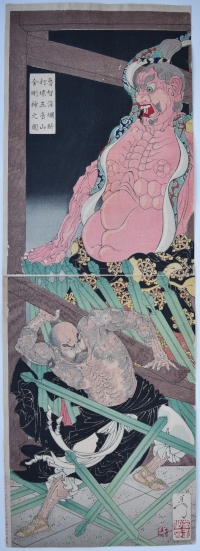
Click here to view image full size.
A vertical diptych showing Rochishin demolishing the temple gate on Mount Godai. There are conflicting versions of this event: Some suggest he gained entry to kill a gang of thieves. However, it seems that he was drunkenly staggering back to the temple after consuming a large quantity of wine and is barred entry by the monks. In a temper he demolishes the entrance and the large Buddhist guardian figure (Kongojin). The abbot dismisses him and sends him to a lesser temple. Rochishin ransui Godaisan Kongojin o uchikowasu no zu, “Picture of Rochishin in a Drunken Rage Demolishing a Guardian Statue (Kongojin) on Mount Godai.” Published by Matsui Eikichi, 1887. He figures in the Chinese classic Tales of the Water Margin, the Suikoden (jp. Suikoden) and is often referred to as the “Flower priest” because of his floral tattoos.
Very fine impression: This is the earliest state with a pigment used on the guardian’s torso that does not oxidise. (Exactly the same can be seen on the first editions of the Kinryusan Temple at Asakusa from Hiroshige’s 100 Views of Edo. Later printings use a different pigment on the huge lantern that oxidises badly.) It was also republished by Shimizuya Tsunejiro. Extensive burnishing. Fine colour. Very good condition. Signed Yoshitoshi.
Status: Available
